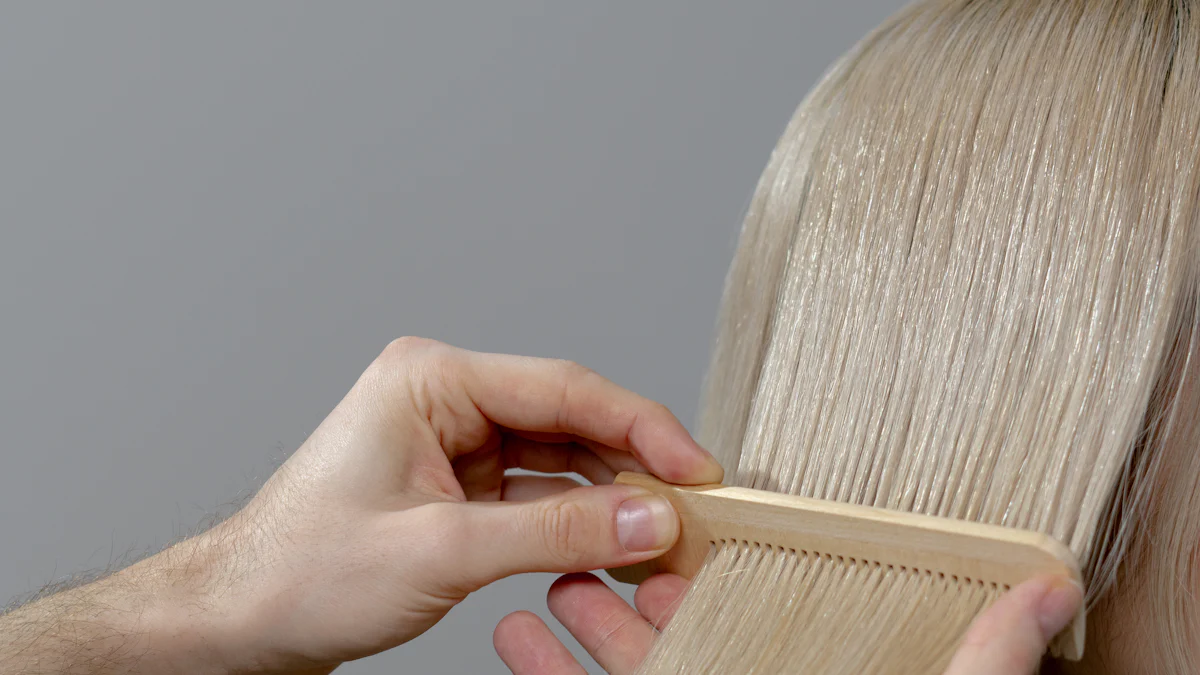Expert Tips: How to Apply Lace Front Wigs with Video Tutorials

Lace front wigs have become a go-to choice for achieving natural-looking hairstyles. These wigs offer versatility and a seamless appearance, making them popular among fashion enthusiasts. If you're wondering how to apply lace front wigs, you can install them using two main methods: with glue or glueless. Each method provides unique benefits, catering to different preferences and needs. For more tips and tricks, check out Luvmeforyou for comprehensive guides on how to apply lace front wig effortlessly.
Preparation
Preparing Natural Hair
Before applying a lace front wig, you need to prepare your natural hair. Proper preparation ensures a smooth and secure fit.
Cornrowing
Cornrowing your hair creates a flat base for the wig. Start by parting your hair into small sections. Braid each section close to the scalp. Secure the ends with small rubber bands. Cornrows help keep your hair neat and prevent lumps under the wig.
Slicking Back with Gel
For a quick and easy method, slick your hair back with gel. Apply a generous amount of gel to your hair. Use a fine-tooth comb to smooth your hair back. This method works well for short hair or when you’re in a hurry.
Braiding
Braiding is another effective way to prepare your hair. Divide your hair into several sections. Braid each section tightly and secure the ends. Pin the braids flat against your scalp. This technique keeps your hair tidy and provides a stable base for the wig.
Tools and Products Needed
Having the right tools and products makes the wig application process smoother and more efficient.
Wig Stocking Cap
A wig stocking cap holds your natural hair in place. It creates a smooth, flat surface for the wig to sit on. Choose a cap that matches your skin tone for a seamless look.
Alcohol Prep Pads
Alcohol prep pads clean your hairline before applying the wig. Wipe your hairline with an alcohol pad to remove oils and dirt. This step ensures better adhesion if you’re using glue.
Wig Grip
A wig grip prevents your wig from slipping. Place the wig grip around your head, just behind your hairline. The grip keeps the wig secure throughout the day, especially if you’re opting for a glueless method.
Wig Clips and Combs
Wig clips and combs help secure the wig to your natural hair. Sew the clips and combs into the wig’s interior. Attach the clips and combs to your braids or slicked-back hair. This adds extra security and prevents the wig from shifting.
Installation with Glue

Applying Glue Along the Hairline
Step-by-Step Guide
Applying a lace front wig with glue ensures a secure fit. Follow these steps for a successful application:
-
Clean your hairline with alcohol prep pads. This removes oils and dirt.
-
Apply a thin layer of Active Lace Wig Adhesive along your hairline. Use a small brush for precision.
-
Wait for the glue to become tacky. This usually takes a few minutes.
-
Carefully place the lace front wig on your head. Align the lace with your natural hairline.
-
Press the lace into the glue. Use a comb to smooth the lace down.
Tips for Even Application
Achieving an even application of glue is crucial. Here are some tips:
-
Use small amounts of glue. Too much glue can cause a mess.
-
Apply glue in sections. This helps control the amount used.
-
Smooth the glue with your thumb. This ensures an even layer.
-
Avoid touching the glue with your fingers. Oils from your skin can affect adhesion.
Using a Wig Cap
How to Secure the Cap
A wig cap provides a flat base for the lace front wig. Follow these steps to secure it:
-
Place the wig cap over your hair. Make sure all hair is tucked inside.
-
Position the cap just behind your hairline. This prevents the cap from showing.
-
Use bobby pins to secure the cap. Place pins around the edges for a snug fit.
Ensuring a Flat Base
A flat base ensures a natural look. Here’s how to achieve it:
-
Smooth your hair under the cap. Use a comb to eliminate bumps.
-
Choose a cap that matches your skin tone. This helps the lace blend seamlessly.
-
Ensure the cap is tight but comfortable. A loose cap can cause the wig to shift.
Securing the Lace Front Wig
Ensuring a Secure Bond with Glue
Securing the lace front wig properly is essential. Follow these steps:
-
Press the lace into the glue. Use a comb to press down firmly.
-
Allow the glue to dry completely. This usually takes about 15 minutes.
-
Check for any loose areas. Apply more glue if needed.
Cutting Excess Lace
Cutting excess lace gives a natural look. Here’s how to do it:
-
Use sharp scissors for a clean cut.
-
Cut close to the hairline. Leave a small margin of lace.
-
Trim carefully around the ears. This ensures a comfortable fit.
Styling After Installation
Styling your lace front wig completes the look. Follow these tips:
-
Use a wide-tooth comb to style the wig. This prevents damage to the lace.
-
Apply foundation to the lace. This helps blend the lace with your skin.
-
Create baby hairs for a natural look. Use a small brush and gel for styling.
Installation without Glue

Preparing Natural Hair
Using a Wig Cap
A wig cap helps keep your natural hair flat and secure. First, place the wig cap over your head, ensuring all hair is tucked inside. Position the cap just behind your hairline. Use bobby pins to hold the cap in place if necessary. This step creates a smooth base for your glueless lace front wig.
Using a Wig Grip
A wig grip adds an extra layer of security. Place the wig grip around your head, just behind your hairline. The grip should feel snug but comfortable. This tool prevents the wig from slipping throughout the day. A wig grip works well with a glueless lace front method.
Securing the Wig
Utilizing Wig Clips and Combs
Wig clips and combs help anchor the wig to your natural hair. Sew the clips and combs into the interior of the wig. Attach the clips and combs to your braids or slicked-back hair. This method provides additional security without using glue. Wig clips and combs make it easy to adjust the wig as needed.
Using Elastic Straps
Elastic straps offer another way to secure your wig. Many wigs come with adjustable straps inside. Tighten the straps to fit your head comfortably. Elastic straps ensure the wig stays in place all day. This method works great for those who prefer a glueless lace front wig.
Achieving a Natural Hairline
Cutting Lace
Cutting the lace properly makes a big difference. Use sharp scissors for a clean cut. Trim the lace close to the hairline, leaving a small margin. Be careful around the ears to ensure a comfortable fit. Properly cut lace blends seamlessly with your skin.
Creating Baby Hairs
Baby hairs add a realistic touch to your wig. Use a small brush and gel to style the baby hairs along the hairline. Create short, fine hairs that mimic natural growth. Baby hairs enhance the overall appearance of your glueless lace front wig. This step gives a polished, natural look.
Pro Tips
Choosing the Right Lace Color
Selecting the correct lace color is crucial for a natural look. A lace front wig should blend seamlessly with your skin tone. For lighter complexions, opt for light brown lace. Medium brown lace suits darker skin tones like Naomi Campbell's. Avoid lace colors that create a dark cast or unmelted appearance. Always match the lace to your skin tone for the best results.
Sizing the Wig Correctly
Proper wig sizing ensures comfort and security. Measure your head circumference before purchasing a lace front wig. Use a flexible tape measure for accuracy. Start at your forehead, wrap around your head, and note the measurement. Compare this to the wig size chart. An accurate fit prevents the wig from shifting or feeling too tight. Adjust the elastic straps inside the wig for added comfort.
Cutting Lace Properly
Cutting the lace correctly enhances the wig's natural appearance. Use sharp scissors for a clean cut. Trim the lace close to the hairline, leaving a small margin. Be careful around the ears to ensure a comfortable fit. Properly cut lace blends seamlessly with your skin. Take your time to avoid mistakes. Practice makes perfect when cutting lace.
Enhancing the Wig's Appearance with Foundation
Foundation can make your lace front wig look more natural. Foundation helps blend the lace with your skin tone. Follow these steps to achieve a flawless finish.
-
Choose the Right Foundation: Pick a foundation that matches your skin tone. Liquid foundation works best for this purpose. Use a shade that blends seamlessly with your complexion.
-
Apply Foundation to the Lace: Use a makeup brush or sponge. Dab a small amount of foundation onto the lace. Focus on the hairline and parting areas. Ensure even coverage without overloading the lace.
-
Blend the Foundation: Blend the foundation into the lace. Use gentle, circular motions. This helps the foundation penetrate the lace fibers. Blending creates a smooth transition between the lace and your skin.
-
Set the Foundation: Use a setting powder to lock in the foundation. Lightly dust the powder over the lace. This prevents the foundation from rubbing off. Setting powder also reduces shine, enhancing the natural look.
-
Check for Consistency: Examine the lace under different lighting conditions. Ensure the foundation matches your skin tone in both natural and artificial light. Adjust the foundation if needed for a perfect match.
-
Reapply as Necessary: Touch up the foundation throughout the day. Carry a small makeup kit for quick fixes. Reapplying ensures the lace remains invisible and the wig looks fresh.
Using foundation can transform the appearance of your lace front wig. This simple technique enhances the overall look, making the wig blend seamlessly with your skin.
Applying a lace front wig can transform your look. Preparation is key. Cornrow, slick back, or braid your hair. Use a wig cap, alcohol prep pads, and wig grip. For glue installation, apply glue evenly and secure the lace. For glueless, use wig clips, combs, and elastic straps. Pro tips include choosing the right lace color, sizing the wig correctly, and using foundation for a natural appearance.
Share your preferred installation method in the comments. What challenges have you faced? Your experience can help others.






















